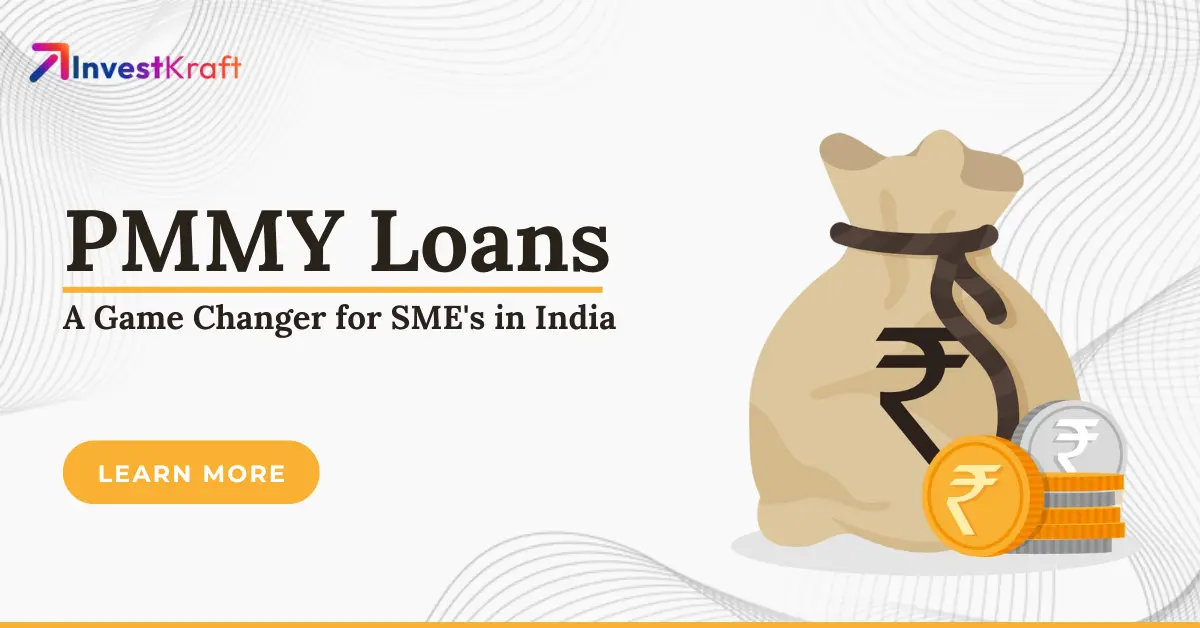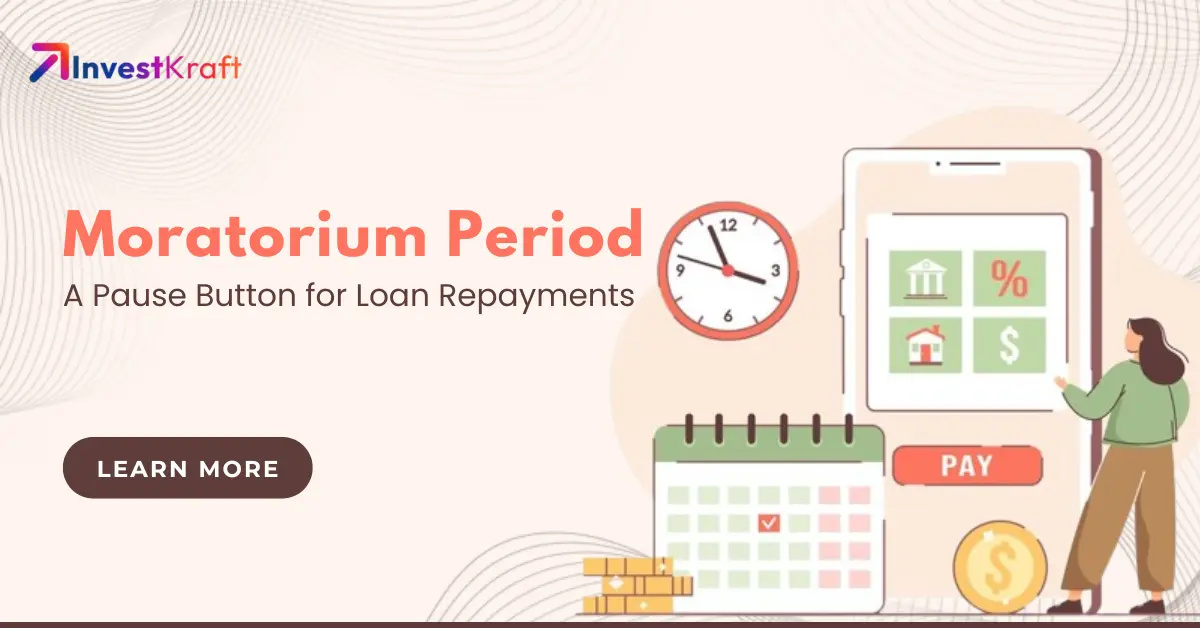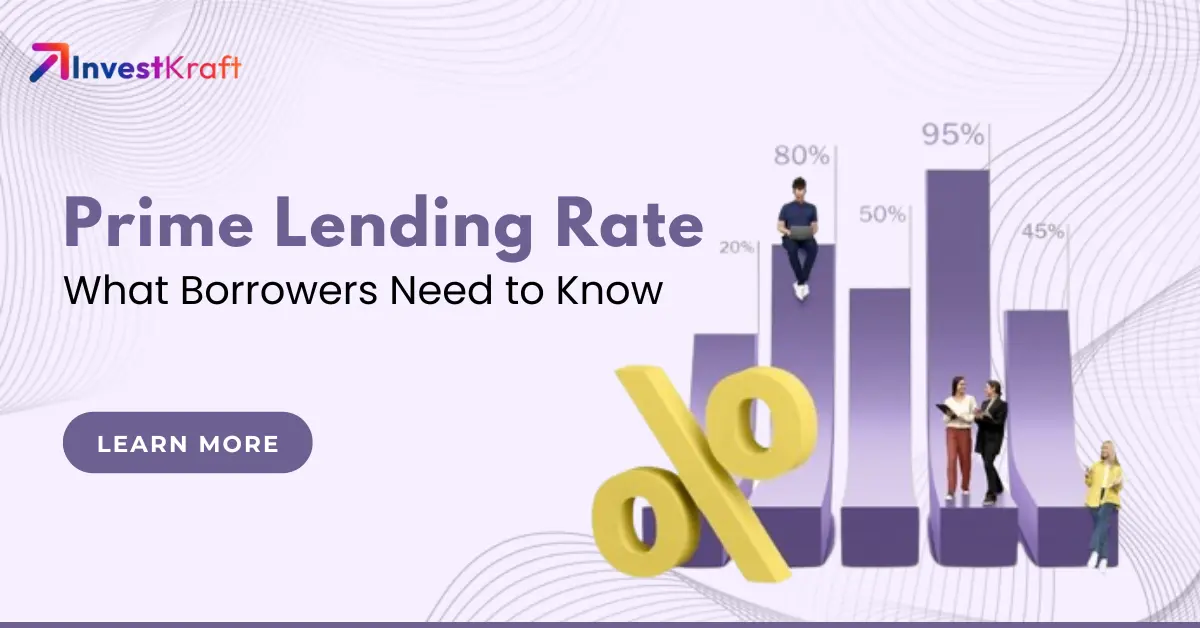Peer To Peer Lending: Transforming the Future of Lending Systems in India

The future of lending in India is undergoing a revolution. Traditional banks no longer monopolize the financial domain. Peer-to-peer (P2P) lending has emerged as an innovative alternative, reshaping how people borrow and invest money. A recent report reveals an astonishing 200% growth in India's P2P lending industry over the past two years. This shift in the lending paradigm offers borrowers attractive interest rates and investors significant returns. Join us as we delve deeper into P2P lending, understanding What is Peer to Peer Lending, its implications, risks, returns, and the pivotal role played by InvestKraft in this new era.
What is Peer-to-Peer Lending?
At its core, P2P lending is a form of crowd-lending that connects borrowers and lenders directly, eliminating the need for intermediaries like banks. It operates on online platforms, allowing individuals to lend money to others seeking funds for personal or business purposes. P2P lending empowers borrowers with easy access to loans and offers lenders a chance to earn attractive returns on their investments.
How does P2P lending work?
In India, Peer to Peer Lending Platforms have gained immense popularity due to their simplicity and efficiency. The process begins with borrowers applying for loans on these platforms, specifying their loan amount and tenure. Once approved, their profiles are listed on the platform, and investors can browse through different borrowers and their credit profiles. Lenders then decide how much they want to invest in each borrower's loan, diversifying their risk across multiple borrowers.
Factors Driving the Growth of Peer-to-Peer Lending in India
The Peer-to-Peer (P2P) lending market has experienced significant growth in recent years, driven by several factors:
- Technology Advancements: Advancements in technology, including the internet and mobile connectivity, have greatly contributed to the rise of P2P lending platforms. By utilizing online systems and algorithms, these platforms connect borrowers directly with individual investors, bypassing the necessity for traditional financial intermediaries such as banks.
- Access to Capital: P2P lending platforms play a crucial role in offering financial support to individuals and small businesses who struggle to secure loans from traditional banks due to reasons such as limited credit history or not meeting strict lending requirements. These platforms also cater to borrowers in emerging markets, where access to conventional financial services may be limited.
- Lower Interest Rates for Borrowers: P2P lending platforms are advantageous due to their ability to provide lower interest rates compared to traditional lenders, making borrowing more affordable for both individuals and businesses. This is possible because P2P lenders eliminate intermediaries and operate online, enabling them to offer cost savings to borrowers in the form of competitive interest rates.
- Diverse Investment Opportunities: P2P lending platforms provide investors with a wide selection of opportunities, such as loans for consumers, small businesses and real estate financing. This variety allows investors to diversify their portfolios, spreading their risk and potentially earning higher returns than they might with traditional investments.
- Transparency and Efficiency: P2P lending platforms offer transparency in terms of pricing, borrower information and terms, enabling investors to make well-informed investment choices. Moreover, the online nature of these platforms simplifies the lending process, saving both borrowers and lenders from excessive paperwork and administrative tasks.
- Global Reach: P2P lending platforms facilitate global lending, connecting investors and borrowers across different regions. This promotes financial inclusion by enabling borrowers in emerging markets to access capital from investors in more developed regions, stimulating economic growth.
- Regulatory Support: Regulatory frameworks for P2P lending have developed globally, creating a favourable environment for industry expansion. These regulations aim to safeguard the interests of investors and borrowers, improve transparency and maintain market stability.
- Changing Consumer Behavior: Consumer preferences are changing rapidly, driven by their increasing comfort with online financial transactions and a growing desire for alternative investment options. As a result, P2P lending platforms have gained significant popularity.
The peer-to-peer lending market has experienced remarkable growth due to various factors such as technological advancements, increased access to capital, lower interest rates for borrowers, diverse investment opportunities, transparency & efficiency, global outreach, regulatory support and changing consumer behaviour. As the industry continues to evolve, P2P lending is expected to have a more significant impact on the broader financial ecosystem.
Regulation norms concerning peer-to-peer lending in India:
The Reserve Bank of India (RBI) has regulated P2P lending to ensure stability and protect investors and borrowers. The regulatory framework includes:
- Exposure Limits: Individual lenders can't lend more than INR 50,000 to the same borrower, and borrowers can't borrow more than INR 10 lakh from all platforms combined.
- KYC and Credit Assessment: P2P platforms must conduct thorough KYC checks and assess borrowers' creditworthiness before listing their loan requests.
- Escrow Accounts: Funds are held in escrow accounts to ensure safe transfers and prevent mismanagement.
- Fair Practices Code: P2P platforms must adhere to ethical lending practices and provide transparent disclosures.
The regulations have boosted confidence, attracted institutional investors, and promoted a fair lending environment. Investkraft, a leading name across the diverse peer-to-peer lending platforms, complies with all regulations, providing a secure platform for lenders and borrowers.
P2P Lending vs Traditional Lending
The main distinction between P2P lending and a bank loan lies in the source of funds. P2P loans obtain money from individual or corporate lenders through an online platform, allowing them to allocate portions or the entirety of the loan. Consequently, you repay the platform, which subsequently distributes the repayments to the lenders.
Conversely, traditional loans involve directly collaborating with the bank to acquire funding and repay the loan. Listed below are some of the important differences between traditional lending and peer-to-peer lending.
| Particular | P2P Lenders | Traditional Lenders (Banks) |
| Application Process | The application process is simple and convenient, allowing you to complete it entirely online. | The application process can be completed online, by phone, or in person. |
| Qualifications | Flexibility in application criteria and requirements. | Stricter borrower and credit requirements. |
| Approval Timing | Quick application, approval, and funding process. | The process may be longer due to stricter requirements. |
| Loan Use | It can be used for virtually anything. | |
| Loan Amount | Maximum 50 lakh rupees in special cases. | Banks offer 1,000 to 40 lakh rupees. |
| Customer Support | Insufficient borrower support and few protections. | Support for borrowers: online, in-person, or by phone. Protections for existing customers. |
Different Types of P2P Loans Available in India
Provided below are the different types of P2P loans that are currently available in India -
- Consumer Loan: A personal loan used for general expenses like electronics, appliances, or other personal needs.
- Education Loan: Financing to cover educational expenses, including tuition fees, books, and other academic costs.
- Auto Loan: A loan specifically for purchasing a vehicle, such as a car or motorcycle.
- Medical Emergency/Bill Loan: Quick funding to handle medical emergencies or pay off unexpected medical bills.
- Life Event Loan: A loan for significant life events, like weddings, anniversaries, or other personal milestones.
- Home Improvement Loan: Funds to renovate, repair, or improve your home.
- Pay-off Credit Card Bills Loan: A loan to clear outstanding credit card debts at a potentially lower interest rate.
- Vacation Loan: Financing for travel and vacation expenses, covering flights, accommodations, and more.
- Small Business Loan: Capital to start, grow, or support the operational needs of a small business.
- Debt Consolidation Loan: A loan to consolidate multiple debts into one manageable payment with a single interest rate.
Also Read: Top 10 P2P Lending Companies in India 2024
Is Peer-to-Peer Lending Safe?
Peer-to-peer lending is less secure than a bank account or certificate of deposit, however, the financing costs are in many cases a lot higher. This is because individuals who put resources into a peer-to-peer lending site expect a large portion of the risk, which is typically accepted by banks or other monetary establishments.
Primary Risks Associated with P2P Lending
While P2P lending presents a promising avenue for investment, it's essential to acknowledge the associated risks. Like any investment, P2P lending comes with the possibility of default, affecting the returns on investment. However, platforms like Investkraft mitigate these risks by thoroughly vetting borrowers and offering diverse investment options.
Here are some of the risks associated with P2P lending:
- Default Risk: There is a chance that borrowers may default on their loan repayments, leading to a loss of principal and interest for lenders.
- Lack of Liquidity: P2P lending investments are not as liquid as traditional investments like stocks or mutual funds. It may take time to find buyers for loan parts if you wish to exit early.
- Platform Risk: The success of P2P lending heavily relies on the platform's stability and effectiveness. A poorly managed platform could impact the overall investment experience.
Strategies to Mitigate Default Risk in P2P Lending
Peer-to-peer (P2P) lending has become a popular investment option in recent times, offering stable and lucrative returns on a global scale. While it is considered a risk-based asset class, lenders can take several proactive measures to effectively reduce these risks.
Below are a few measures that can be taken to mitigate risks effectively.
- P2P lending in India is regulated by the RBI, which implemented guidelines in October 2017. These guidelines provide a framework for establishing and operating P2P lending platforms. The regulations have been well received in India, considering the challenges faced by the P2P lending sector in China. Clear regulations increase lender confidence by providing structure and credibility.
- The biggest risk in lending is default. There are two types of default risk - intentional and due to capability. Defaults lower credit scores and affect a borrower’s financial credibility and ability to get future loans. Reporting to the bureau deters intentional defaulters.
- P2P lending platforms assess borrowers’ intention, stability and ability using 400 data points and 120+ parameters. Physical verification is done at the borrower’s office and residence.
- It is important to acknowledge unforeseen circumstances can sometimes make it difficult to repay their loans on time. This information is openly available on the borrower’s listing, allowing lenders to make informed decisions when offering loans.
- Diversifying your portfolio can help to reduce risk by spreading investments across different loans. This risk management strategy is aimed at avoiding putting all your investments into just one type of loan. By diversifying in P2P lending, lenders can protect their investments from potential risks associated with being exposed to only a few loans or loans of limited scope.
- Lenders should take advantage of processes like “Fractionalization” which allows them as little as 500 rupees per loan and auto-invest (an automated mechanism that invests on their behalf in pre-selected loans). These processes provide convenient and efficient ways for lenders to diversify their investments and increase their potential returns.
Understanding how returns are calculated in P2P lending is crucial. Net Annualized Return (NAR) is the widely accepted measure for calculating returns in this platform, similar to fixed income instruments. Lenders need to track returns, make adjustments if needed and manage risk to protect NAR from any negative impact.
The Power of P2P Lending: A Case Study
Let's take a look at a real-life case study to understand the potential of P2P lending. Meet Ramesh, a small business owner in Delhi looking to expand his operations. Traditional banks have turned down his loan applications due to a lack of collateral. Frustrated but determined, Ramesh turns to a P2P lending platform, where his business plan and creditworthiness are assessed based on multiple factors. Within days, Ramesh secures the funding he needs from multiple lenders, each contributing a small portion of the loan amount. Thanks to P2P lending, Ramesh's business flourishes, and the lenders enjoy attractive returns on their investments.
Familiarising with the Earning Potential of P2P Lending
Peer to Peer-to-peer lending in India offers an enticing opportunity for investors to earn attractive returns. The potential returns depend on several factors, making it essential to understand the variables that impact your earnings. Here's what you need to know:
- Diversification Benefits: Spreading your investments across multiple borrowers can help mitigate risks and enhance overall returns.
- Risk-Reward Tradeoff: Higher returns usually come with higher risk. Evaluate your risk appetite and align your investments accordingly.
- Interest Rates: Different borrowers offer varying interest rates based on their credit profiles. Selecting loans with competitive interest rates can boost your earnings.
- Loan Tenure: Shorter loan tenures often result in quicker returns, providing flexibility for reinvestment.
- Reinvestment Strategy: Reinvesting earned interest and principal can compound returns over time, accelerating your wealth accumulation.
- Platform Fees: Consider platform fees while calculating returns, as they can impact the overall profitability.
By strategizing your investments and leveraging the power of diversification, P2P lending can offer returns ranging from 12% to 24%. As with any investment, conduct due diligence and make informed decisions to maximize your earnings and achieve your financial goals. Embrace the earning potential of P2P lending and embark on your journey towards financial prosperity.
Tax Implications of P2P Lending Returns
When it comes to P2P lending returns, understanding the taxation aspect is crucial for maximizing your earnings. The interest earned from P2P investments is considered income and is subject to taxation based on your applicable income tax slab. Here's what you need to know:
- Tax Slab: The income earned from P2P lending is added to your overall income and taxed as per your tax slab, which varies depending on your total income.
- TDS Deduction: P2P lending platforms are required to deduct TDS (Tax Deducted at Source) at a rate of 5% on the interest earned by lenders if it exceeds a specified threshold.
- Tax Benefits: Investors can offset any losses from P2P lending against other income to reduce their overall tax liability.
Be mindful of the tax implications and plan your investments strategically to make the most of P2P lending returns while staying tax-efficient.
Future Trends and Innovations in Peer-to-Peer Lending
The global P2P lending market is predicted to achieve a CAGR (Compound Annual Growth Rate) of 28.1% from 2023 to 2032. It is expected to reach a valuation of 621.3 billion US Dollars by 2032. The P2P market is currently valued at approximately 1,526 million US Dollars.
Discussed below are some of the expected future trends and innovations in peer-to-peer lending we might witness in the upcoming decade or so.
- Advances in Technology: P2P lending platforms utilize AI algorithms and big data analytics to effectively connect borrowers with lenders. These technological advancements improve loan processing, risk assessment, and decision-making processes, ultimately enhancing the user experience.
- High Returns for Investors: P2P lending is an alternative asset class that offers higher returns compared to traditional options such as savings accounts and bonds. Investors can diversify their portfolios by funding multiple loans, which helps mitigate risk while seeking attractive yields.
- Decreased Interest Rates: Borrowers are increasingly drawn to P2P lending because it offers a more cost-effective alternative to traditional loans. The reduced overhead and absence of intermediaries result in competitive interest rates and flexible loan terms, making it an attractive option for those seeking affordable financial solutions.
- Regulation and Market Growth: Clear regulations and standards in the P2P lending market are crucial for building trust among investors and maintaining a stable lending environment. As the market continues to evolve and mature, the involvement of institutional investors becomes increasingly important, as it contributes to injecting more capital and supporting overall growth.
- Convenient Online Services: P2P lending offers borrowers and investors a convenient and accessible online platform. The digital nature of these platforms enables quick loan processing, credit checks and fund transfers. This makes P2P lending a user-friendly option in today’s digital age.
- Various Types of Loans Available: P2P lending platforms provide a variety of loan options, including personal loans, student loans, medical loans, real estate financing, and business loans catering to diverse borrower needs. This wide range of offerings appeals to a larger audience and contributes to the growth of the market.
- Traditional Banking Disruption: P2P lending has revolutionized banking by providing a faster and more customer-oriented lending experience. By reducing bureaucratic hurdles and speeding up loan approvals, P2P lending has become popular among borrowers who need immediate access to funds. This disruption has forced traditional banks to rethink their lending methods and adjust to the evolving market.
Investkraft: Your Ideal Partner for Best-in-Class Peer-to-Peer Lending in Delhi
When on the lookout for premium services for Peer Peer Lending in Delhi, look no further than Investktaft. Our extensive range of financial services, including P2P investments, is designed to provide borrowers with quick and convenient loans and investors with attractive returns. With Investkraft as your trusted partner, you can navigate the P2P lending landscape with confidence. Cherish the power of P2P lending and embark on your journey approaching financial growth with Investkraft by your side!
Conclusion
Now that you know What is Peer to Peer Lending, keep in mind that by offering borrowers easy access to loans and investors attractive returns, it is effortlessly reshaping the future of lending in India. As you consider entering this dynamic space, remember to assess your risk tolerance and financial goals. With Investkraft as your reliable partner, you can navigate the P2P lending landscape with confidence. Whether you're a borrower seeking funds or an investor looking for opportunities, when it comes to seeking reliable yet efficient Peer Peer Lending Platforms, Investkraft is your gateway to financial success.
Verify Phone Number
Related Post

Top Loan Schemes with Highest Subsidies in India 2024
Find the Indian loans with the highest subsidy easily with the help of Investkraft. This guide provi...
Read more...
Pradhan Mantri Mudra Yojana (PMMY) Loan: Eligibility, Application Form, Benefits
The Pradhan Mantri Mudra Yojana (PMMY) loan has been a game changer for small and micro-enterprises...
Read more...
How Does the RBI Regulate P2P Lending in India 2024?
P2P lending has grown significantly in India, becoming an important part of the financial ecosystem....
Read more...
Grace Period vs Moratorium Period: A Detailed Comparison for Better Financial Decisions
The terms “moratorium period” and “grace period” are often mistaken to have the same meaning. Howeve...
Read more...
List of Microfinance Companies in India 2025 – Small Loans & Financial Services
Microfinance in India has been rapidly expanding as a viable financial service due to the emergence...
Read more...
Understanding Syndication Loans: A Guide for Borrowers and Lenders
Loan syndication is a solution for borrowers seeking large loans that may be beyond a single lender’...
Read more...
How Does the Moratorium Period Act as a Life Raft for Borrowers?
Financial jargon, whether taking a loan or opening a bank account, can be confusing and tricky. Thes...
Read more...
New to Credit? Stop Worrying and Build Your Credit with These Essential Tips
Establishing and maintaining a healthy credit score can seem overwhelming, particularly for new borr...
Read more...
Prime Lending Rate: A Friend or Foe for Borrowers?
When purchasing items on credit, it is common to need a financial investment and many turn to loans...
Read more...
Instant Cash Loans: Everything You Need to Know
Have you ever been in a situation where you did not have enough money to make a purchase? Maybe you...
Read more...Reach out to our Experts if you have any Doubts
Like the best things in life, Consultations @InvestKraft are free
Drop a Mail or give us a Missed Call & Begin your Investment Journey here



